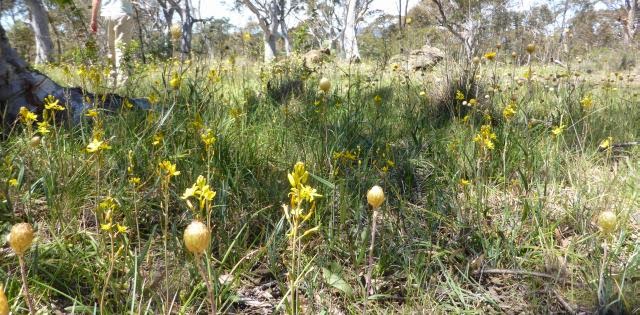A planty visit to the 6 Mile Reserve
I have previously discussed the name of this TSR in terms of its geography. Wherever it is 6 miles from, it puts on a very good show of native flowers in Spring. Here are a couple of panoramas.
The first features Bulbine bulbosa, Craspedia variabilis and Podolepis jaceoides.
This is primarily Podolepis jaceoides, many of them in bud form. Plus a small dog which is allowed in a TSR.
The main business was various swathes of Asteraceae (I still reckon Compositae is a more descriptive name!)
Leucochrysum albicans tricolor in 1.5 colour forms!
Coronidium scorpioides
Brachyscome rigidula (I couldn't get the leaves in focus: sorry)
Calotis scabiosifolia (ditto)
Fabaceae (the beans) were also well represented, Dillwynia sericea.
Bossiaea buxifolia (leaves in image for once).
Pultenaea subspicata: More leaves!
Velleia paradoxa
OK, it's bluebell time. I will now go and wash my fingers out and get down to Wahlenbergias of 3 varieties. First up is the small W multicaulis with small sepals that don't get to the end f the floral tube.
It also has a tripartite style.
The bigger species seen on the day was W. stricta which has hairy leaves.
Back down to small, going on tiny, we have W gracilis with sepale that do reach the end of the floral tube.
The style isn't so obviously split.
The first features Bulbine bulbosa, Craspedia variabilis and Podolepis jaceoides.
This is primarily Podolepis jaceoides, many of them in bud form. Plus a small dog which is allowed in a TSR.
The main business was various swathes of Asteraceae (I still reckon Compositae is a more descriptive name!)
Leucochrysum albicans tricolor in 1.5 colour forms!
Coronidium scorpioides
Brachyscome rigidula (I couldn't get the leaves in focus: sorry)
Calotis scabiosifolia (ditto)
Fabaceae (the beans) were also well represented, Dillwynia sericea.
Bossiaea buxifolia (leaves in image for once).
Pultenaea subspicata: More leaves!
Velleia paradoxa
OK, it's bluebell time. I will now go and wash my fingers out and get down to Wahlenbergias of 3 varieties. First up is the small W multicaulis with small sepals that don't get to the end f the floral tube.
It also has a tripartite style.
The bigger species seen on the day was W. stricta which has hairy leaves.
Back down to small, going on tiny, we have W gracilis with sepale that do reach the end of the floral tube.
The style isn't so obviously split.



















Comments